Unit Profile
Nickname(s): "Rock of the Marne", "Blue and White Devils"
Located: Fort Stewart, Georgia
War Service Area: Europe
Images3rd Infantry Division Group Photo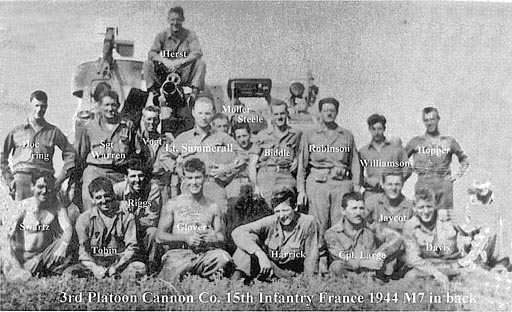 3rd Infantry Division Soldiers
3rd Infantry Division Soldiers 3rd Infantry Div., 2nd Bn. Taking a break
3rd Infantry Div., 2nd Bn. Taking a break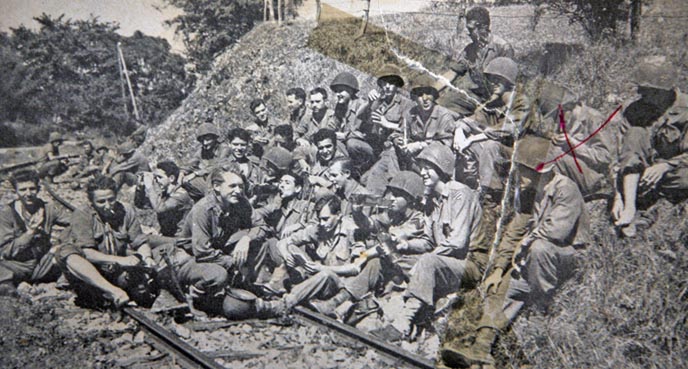 1920 Newspaper on the 3rd Infantry Division
1920 Newspaper on the 3rd Infantry Division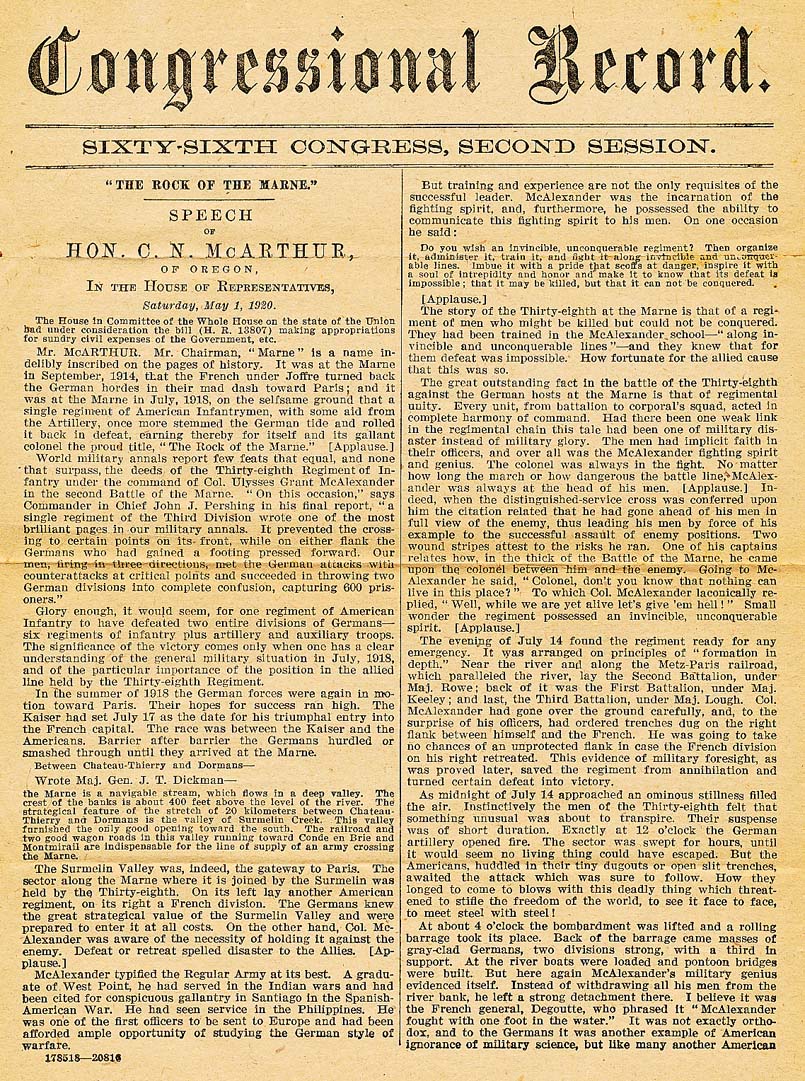 Old Article "3rd ID Races To end World War II"
Old Article "3rd ID Races To end World War II"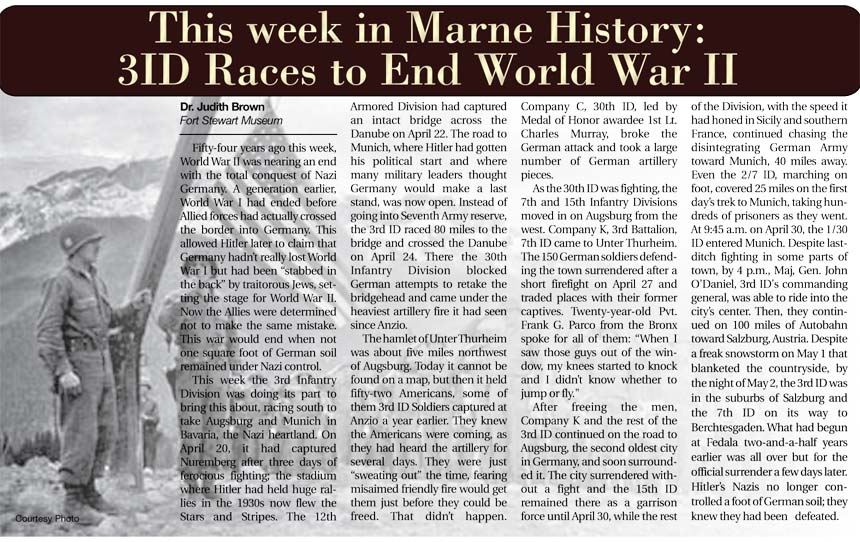 2003 Article on the famouse 3rd Infantry Division
2003 Article on the famouse 3rd Infantry Division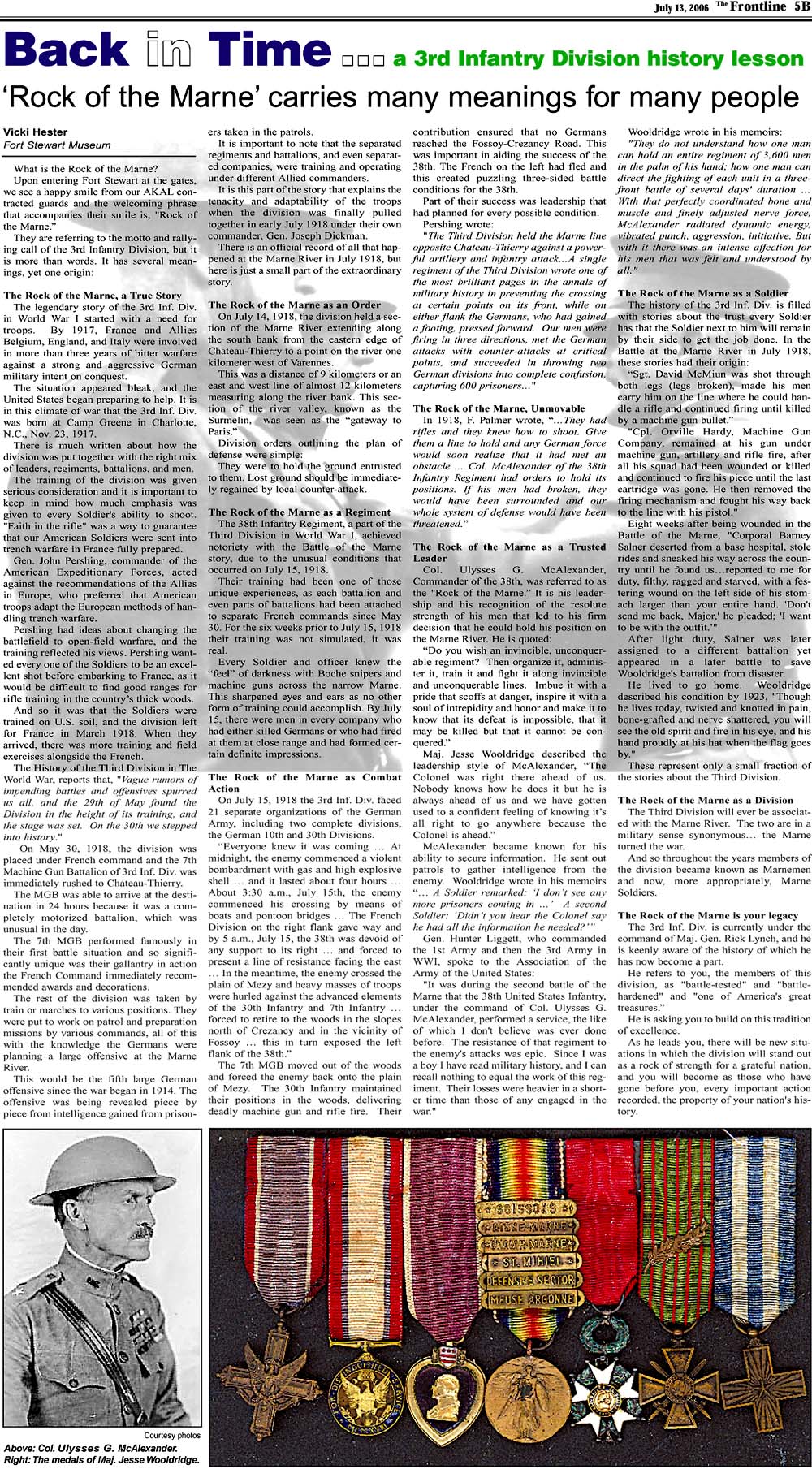 ______________________________________HISTORY (WWI - Operation Iraq Freedom)
______________________________________HISTORY (WWI - Operation Iraq Freedom)The 3rd Infantry Division has one of the most successful combat records of any U.S. Army division. It has paid a high price for this distinction, suffering nearly 35,000 wartime casualties.
Fifty-one members of the 3rd Infantry Division have been awarded the Medal of Honor while serving our nation.
World War I (1914-1918)The Third Division was born at Camp Green, North Carolina on November 21, 1917. The U.S. had been at war with Imperial Germany and allies since April 6, 1917. The 3rd Division was composed of the 4th, 7th, 30th, and 38th Infantry Regiments, the 10th, 18th, and 76th Field Artilleries, and the 6th Engineers, with a total of 28,000 men. The Division arrived in France in April 1918 at the beginning of the last series of German offensives designed to end the war. By May of 1918 the French had been pushed back to within 50 miles of Paris. The 7th Machine Gun Battalion of the 3rd Division rushed to Chateau-Thierry amid retreating French troops and held the Germans back at the Marne River. The rest of the division was absorbed by the French Command until brought back together under the Command of Gen. Joseph Dickman and by July 15, 1918 they took the brunt of what was to be the last German offensive of the war. As units on either side of the division were driven back, men of the 30th and 38th Infantry Regiments held their positions at the Marne River, defeating the German bid for Paris. For this the division earned the nickname, "Rock of the Marne."
World War II (1941-1945)The 3rd Division was redesignated the 3rd Infantry Division in 1941. It was the only division to fight Germany on all fronts in WWII. Their days in combat numbered 531. The division entered the war in Fedala, North Africa, just north of Casablanca, as part of the first American campaign against the Nazi threat in the Torch Invasion. They moved across Morocco to Tunisia and embarked for Sicily. The 3rd Infantry Division arrived in Italy on September 18, 1943, then detached for the amphibious operation designed to break the stalemate in the Italian campaign at Anzio. They landed at Anzio on January 22, 1944. Hitler wanted the Anzio beachhead eliminated. From January to May, the Germans launched attacks in an effort to drive the Allies from the beach. Just as they were at the Marne River in World War I, the 3rd Infantry Division proved to be an unmovable rock of resistance. By May the Allies broke the German hold and reached Rome by June 4, 1944. The division was called to another amphibious assault invading Southern France in August of 1944, then up the Rhone River to join other American units in northeastern France and into Germany capturing Hitler's mountain retreat, Berchtesgaden. The division ended the war in Salzburg, Austria on May 6, 1945.
Korean War (1950-1953)When North Korea invaded the border of South Korea in 1950, the 3rd Infantry Division was one of ten active divisions in the U.S. Army. Manpower shortages resulted in the 30th Infantry Regiment and the 41st Field Artillery loaned out to replace members of other units. The 3rd Infantry Division was brought up to strength with Republic of Korea replacements and the addition of the "Borinqueneers", the 65th Infantry Regiment from Puerto Rico. The division arrived in Korea in September 1950 and joined in the operations in the Hamhung-Hungnam area. On November 23, 1950 China entered the war and the massive strength of the Chinese Army was felt all along the front. The Allies were forced to retreat. From November 30 to December 24, the 3rd Infantry conducted the most massive beachhead evacuation in American military history: 105,000 troops, 100,000 refugees, 17,500 vehicles, and 750,000 tons of cargo. By 1951, elements of the 3rd ID helped recapture Seoul, the Korean capital, and the Chinese were pushed back to the 38th Parallel. As the Chinese tried to recapture the capital, the brunt of the attack fell on the 3rd Infantry Division's sector and the Marne division became the "Rock of Seoul." Again the Chinese were driven back to the 38th Parallel and the 3rd Infantry Division settled into front-line duty, defending all attempts by the Chinese to seize strategic positions. The war ended in July 1953 and by October 1954 the division returned to Ft. Benning, Georgia.
Cold War (1947-1991)From 1958 to 1996, the 3rd Infantry Division was stationed in Germany as part of the main defense protecting Western Europe from the threat of attack by Warsaw Pact Nations headed by the Soviet Union. The division remained on constant alert as the arms race continued.
Persian Gulf War (1991)On August 2, 1990, Iraq invaded Kuwait and a request for help resulted in a large deployment of troops and equipment known as Desert Shield. A Nuclear Biological Chemical Reconnaissance Platoon from the 3rd ID's 92nd Chemical Co., units of the 3rd Brigade and supporting units were attached to the 1st Armored Division in Saudi Arabia. The 6th Battalion of the 41st Field Artillery Brigade joined the 210th Field Artillery, of the VII Corps when the 100-hour storm through Iraq began on January 16, 1991. The war was over by February 28. The 3rd Brigade of the 3rd ID had destroyed 105 enemy tanks, 70 enemy armored personnel carriers, 92 enemy trucks, 4 enemy artillery pieces and captured 836 prisoners.
Operation Iraqi Freedom (2003-Present)On March 19, 2003, President Bush announced orders to begin the operation to free the Iraqi people from the tyrannical ruler, Saddam Hussein. The next day elements of the 3rd ID (Mechanized) moved to the Iraqi border. By April 3, the 3rd Infantry Division entered Saddam International Airport and by the next day it was renamed the Baghdad International Airport. On April 5, the 3rd ID stunned the world with television images of tanks and Bradley Fighting Vehicles storming the streets of Baghdad in a probing action known as the first of two "Thunder Runs." The second Thunder Run moved the 2nd Brigade Combat Team into the government center of Baghdad. A decision to stay inside the city created a need for fuel and supplies. Division logistic personnel mounted an effort to resupply the 2nd BCT in the hostile streets of Baghdad as they held the foothold on the banks of the Tigris River, reminiscent of the Division's historic stand at the Marne River during World War I. As the 3rd ID expanded and tightened control of Baghdad and the 1st Marine Expeditionary Unit choked off Iraqi resistance on the east side of the city, Iraqi resistance crumbled. The division returned to Ft. Stewart in August 2003 and by 2004 was selected as the first division in the Army to be organized under the new modular system. In January 2005, the division returned to Iraq and led U.S. and coalition forces in Baghdad. The 1st and 3rd Brigades of the division supported the 42nd Division in Northern Iraq. The hard work created conditions for a secure Iraqi election and transfer of power to the first democratically elected national government in Iraq. The Division served with its coalition partners during Operation Iraqi Freedom III for a year before returning to Georgia in January 2006.
On its return to the United States in 2006, the Third Infantry Division completed its reorganization to the new modular system for infantry divisions and began to prepare for redeployment to Iraq for Operation Iraqi Freedom V. In January 2007 the 1st Brigade Combat Team deployed to Multinational Forces Iraq-West (MNF-W) in Anbar Province under the command of the 1st Marine Division. It was the first brigade in the Army to serve in Iraq three times. The Brigade's area of operations was in central Anbar, primarily in and around Ramadi, the provincial capital. No other brigade in Iraq covered a larger area. The 1st BCT conducted nine brigade-level operations and transformed Ramadi from the second deadliest city in Iraq to its quietest in six weeks; the city had nearly 300 violence-free days during the Brigade's deployment, due to its friendship with the area tribes in the Anbar Awakening, mentorship of the Ramadi municipal government and partnership with Iraqi police and army.
In March 2007 the rest of the Division, except the 4th Brigade, prepared to deploy to Iraq early as part of the "surge" in troops ordered by President Bush in January. The 3ID became the first complete division to serve in Iraq three times. As they deployed, the Pentagon announced the extension of the tours of active duty units in Iraq from twelve to fifteen months. The 3ID units, therefore, served in both OIF V (2007) and OIF VI (2008). On April 4 the Third Infantry Division Headquarters took command of Multinational Forces Iraq-Center (MNF-C) and became known as Task Force Marne. During its fifteen months in Iraq it commanded not only 3ID units but also the 2d BCT, 10th Mountain Division, 4th BCT, 25th Infantry Division, 3rd BCT, 101st Airborne Division, and troops from Georgia, El Salvador, Kazakhstan, and Lithuania. The 3d Brigade Combat Team deployed MNF-C in March-April, followed by the 2nd Brigade Combat Team in May and the 4th Brigade Combat Team in October. Together they secured an area south of Baghdad as large as West Virginia from east of the Tigris River to west of the Euphrates River in land that had once been a stronghold for Al Qaida and other insurgent groups. They lived among and worked with concerned Iraqi citizens and soldiers in more than a dozen operations, first to fight the insurgents, deny them sanctuaries and prevent the use of the former sanctuaries as staging areas for attacks on Baghdad. Having created security, they then worked to rebuild governmental and economic capacity. The 1st Brigade returned to Fort Stewart in April 2008. Headquarters and the remaining brigades, except the 4th Brigade, returned to Fort Stewart, Fort Benning, and Hunter Army Airfield from May-July. The 4th Brigade returned to Fort Stewart in December 2008.
Today, the Third Infantry Division is preparing for new missions and upcoming deployments. Since October 1, 2007 the 1st Brigade Combat Team has trained as part of CCMRF, the U.S. Northern Command's Chemical, Biological, Radiological, Nuclear, and high-yield Explosive Consequence Management Response Force. If such an incident were to occur in the US, it would deploy as the Department of Defense's initial response force to support civil authorities in saving lives, preventing further injury, and providing temporary critical life support. After March 2009 the 4th Brigade Combat Team will begin to transition from a heavy bridge combat team with armor and mechanized infantry units to a lighter infantry brigade combat team. In the process it will lose the 4th Battalion, 64th Armor and gain the 3d Battalion, 15th Infantry. The 3ID is also preparing for the addition of a 5th Brigade Combat Team at Fort Stewart. In the fall 2009 3ID Headquarters, 2nd Brigade Combat Team and 3rd Brigade Combat Team will deploy to Iraq for their fourth tour in that country while other units may deploy to Afghanistan.
What is the Rock of the Marne?Visitors to Fort Stewart and Hunter Army Airfield will hear the phrase "Rock of the Marne" repeated time and again by Soldiers. But what exactly is the Rock of the Marne?.
It all began during World War I when the newly-formed 3rd Division (later re-designated as the 3rd Infantry Division) was in France as part of the American Expeditionary Force. The division's 28,000 Soldiers arrived on Europe's shores prepared to defeat the last wave of German offensives.
At Chateau-Thierry, along the Marne River, as French troops retreated from the German onslaught, men of the 7th Machine Gun Battalion of the 3rd Division were rushed to Chateau-Thierry and set up a defensive position along the Marne River.
Maj. Gen. Joseph Dickman, the division commander, issued his famous order in French, "Nous resterons la" ("We're staying there!"). The rest of the division moved into position along the Marne, and on July 15, took the brunt of what was to be the last German offensive of the war, the famous "Peace Storm."
As units on either side of the division were driven back, men of the 30th and 38th Regiments held their positions, defeating the Germans' bid for victory.
This feat of arms, in which they stood their ground like a rock at the Marne, was called by Gen. John "Blackjack" Pershing "...one of the most brilliant pages in the annals of military history" and earned the 3rd Infantry Division it's nickname: "The Marne Division".
*Salute*
-Dugan
